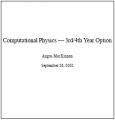
Physical Mathematics
by Michael P. Brenner
Publisher: Harvard University 2010
Number of pages: 250
Description:
The goal of this course is to give a modern introduction to mathematical methods for solving hard mathematics problems that arise in the sciences -- physical, biological and social. Our aim therefore is to teach, within a broad suite of examples, how computer simulations and analytical calculations can be effectively combined. In this course, we will begin with problems that are simple polynomial equations and first order differential equations -- and slowly march our way towards the study nonlinear partial differential equations.
Download or read it online for free here:
Download link
(4.6MB, PDF)
Similar books
 Introduction to Computational Physics
Introduction to Computational Physicsby Franz J. Vesely - University of Vienna
The essential point in computational physics is the systematic application of numerical techniques in place of, and in addition to, analytical methods, in order to render accessible to computation as large a part of physical reality as possible.
(12326 views)
 Computational Physics
Computational Physicsby Angus MacKinnon - Imperial College London
This course aims to give the student a thorough grounding in the main computational techniques used in modern physics. This is not a text in computing science, nor in programming. It focuses specifically on methods for solving physics problems.
(13728 views)
 Introduction to Computational Physics
Introduction to Computational Physicsby Richard Fitzpatrick
The purpose of the text is to demonstrate how computers can help deepen our understanding of physics and increase the range of calculations which we can perform. These lecture notes are writen for an undergraduate course on computational physics.
(18272 views)
 Computational Physics
Computational Physicsby Morten Hjorth-Jensen - University of Oslo
These notes should train you in an algorithmic approach to problems in the sciences, represented here by the unity of three disciplines, physics, mathematics and informatics. This trinity outlines the emerging field of computational physics.
(16066 views)